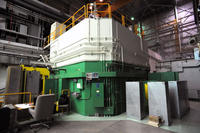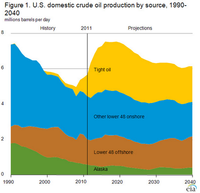-
Government, private sector prioritize cybersecurity education
As government and private sector organizations transmit and store more information electronically, the need for professionals with skills to protect and evaluate sensitive information is increasing. American companies and government agencies are expanding various initiatives aimed at increasing the number of cybersecurity professionals in the country.
-
-
Smaller asteroids could cause bigger problems

On 15 February an asteroid burst over the Russian city of Chelyabinsk. Scientists estimate that the Chelyabinsk event was equivalent to an explosion of about 500 kilotons of TNT. At its peak, the airburst appeared to be thirty times brighter than the sun. The asteroid fireball that injured about 1,500 people and damaged more than 7,000 buildings, collapsing roofs, and breaking thousands of windows. Scientists say that because the frequency of a strike of an asteroid of this size has exceeded expectations, with three such strikes in just over a century – Chelyabinsk in 2013, Tunguska in 2008, and a large airburst in the South Atlantic in 1963 — the number of similar-sized asteroids capable of causing damage may be greater than suspected.
-
-
Study finds more spending on fire suppression may lead to bigger fires
Researchers found that fire management can fall into the firefighting trap: Energy and resources are spent mostly on fire suppression — putting out fires in the moment — while less attention is devoted to fire prevention, such as clearing brush and building fire lanes during the off-season. After severe fires, policymakers funnel even more funds into fire suppression for the next season, but this attention to fire suppression may undermine prevention efforts. The result, counterintuitively, is even worse fires the following season, due to the buildup of fire-prone materials such as dried tinder and dead trees. The researchers emphasize balancing fire suppression with prevention measures.
-
-
Financial decision making, risk taking in the face of changing climate
Maximizing returns on financial investments depends on accurately understanding and effectively accounting for weather and climate risks, according to a new study by the American Meteorological Society. An AMS report concludes that financial investments face a range of risks due to existing weather patterns and climate variability and climate change. Even small changes in weather can impact operations in critical economic sectors. At the same time, climate variability and change can either exacerbate existing risks or cause new sources of risk to emerge.
-
-
Cyberattacks more serious domestic threat to U.S. than terrorism: FBI
The heads of the Federal Bureau of Investigation(FBI), Department of Homeland Security(DHS), and National Counterterrorism Center(NCTC) have declared cyber attacks as the most likely form of terrorism against the United States in the coming years. “That’s where the bad guys will go,” FBI director James Comey said about cyberterrorism. “There are no safe neighborhoods. All of us are neighbors [online].”
-
-
Hundreds of cyber specialists to compete at NetWars Tournament of Champions

SANS Institute’s NetWars Tournament of Champions will be held in Washington, D.C., in mid-December. Hundreds of the brightest security professionals from around the world will compete with each other in order to determine who has the best skills in tackling cyber security challenges.
-
-
U.S. financial industry pushes Congress to pass cybersecurity bill
Three financial-industry trade groups have issued a letter to senior members of the Senate Select Committee on Intelligenceto re-energize a campaign for moving forward with cybersecurity legislation. The trade groups, representing the U.S. largest financial institutions, said their ability to prevent cyberattacks will be hindered unless Congress acts.
-
-
Using biological organisms to convert natural gas to liquid transportation fuel

Researchers will use their expertise in protein expression, enzyme engineering, and high-throughput assays as part of a multiproject, $34 million effort by the Advanced Research Projects Agency-Energy (ARPA-E) aimed at developing advanced biocatalyst technologies that can convert natural gas to liquid fuel for transportation.
-
-
Inkblots bolster security of online passwords
Computer scientists have developed a new password system that incorporates inkblots to provide an extra measure of protection when, as so often occurs, lists of passwords get stolen from websites. This new type of password, dubbed a GOTCHA (Generating panOptic Turing Tests to Tell Computers and Humans Apart), could foil growing problem of automated brute force attacks, and would be suitable for protecting high-value accounts, such as bank accounts, medical records, and other sensitive information.
-
-
Coordinating responses to cloud, infrastructure vulnerabilities
Cybercrime presents a significant threat to individual privacy, commerce, and national security. In order to tackle this cross-border threat properly, agents involved in managing and monitoring cyber-risk-critical assets need to be able to cooperate and co-ordinate their prevention strategies. Platforms enabling coordinated cross-border responses already work well for handling malicious activity on the traditional Internet. The advent of cloud computing, however, has created a new set of challenges for security professionals in securing the platforms that deliver the cloud.
-
-
New drone to monitor radiation following nuclear disasters

Researchers have unveiled a large semi-autonomous drone called the ARM system which could be used to provide visual and thermal monitoring of radiation after a release of nuclear material. The system was developed in response to requirements for radiation monitoring in event of the release of radioactive materials.
-
-
DOE to resume transient testing of nuclear fuels and materials

Transient testing of nuclear fuel involves placing fuel or material into the core of a nuclear reactor and subjecting it to short bursts of intense, high-power radiation in order to analyze the effects of the radiation. The Idaho National Laboratory (INL) Transient Reactor Test Facility began operating on 23 February 1959 and was a principal reactor safety testing facility in the United States for thirty-five years. The U.S. Department of Energy invites the public to read and comment on a draft environmental assessment it has prepared for a proposal to resume transient testing of nuclear fuels and materials.
-
-
U.S. oil production exceeds imports for first time in two decades

The United States is well on its way to energy independence, with the Obama administration announcing Wednesday that domestic oil production surpassed imports for the first time in nearly two decades. A report by the U.S. Energy Information Administration (EIA) offers proof that the United States has managed both to increase domestic oil and gas drilling and reduce the nation’s carbon emissions, which have dropped to a 20-year low. Since 2008, U.S. crude oil output has increased 50 percent, while imports have fallen about 20 percent.
-
-
Drive-by charging: Advancing wireless power transfer for vehicles
Researchers have developed new technology and techniques for transmitting power wirelessly from a stationary source to a mobile receiver — moving engineers closer to their goal of creating highway “stations” that can recharge electric vehicles wirelessly as the vehicles drive by.
-
-
The Philippines is victim of geography, poor infrastructure, poverty
Owing to its location and geography, the Philippines is one of the most natural disaster-prone countries in the world. On average the country experiences nine major typhoons and 900 earthquakes annually, and it has twenty-five active volcanoes. Poor infrastructure and pervasive poverty exacerbate the impact of disasters, making them even more deadly and destructive. “In a cruel cycle, poverty and underdevelopment make disasters worse, and disasters make poverty and underdevelopment worse,” one observer notes.
-
More headlines
The long view
Water Wars: A Historic Agreement Between Mexico and US Is Ramping Up Border Tension
As climate change drives rising temperatures and changes in rainfall, Mexico and the US are in the middle of a conflict over water, putting an additional strain on their relationship. Partly due to constant droughts, Mexico has struggled to maintain its water deliveries for much of the last 25 years, deliveries to which it is obligated by a 1944 water-sharing agreement between the two countries.
Trump Is Fast-Tracking New Coal Mines — Even When They Don’t Make Economic Sense
In Appalachian Tennessee, mines shut down and couldn’t pay their debts. Now a new one is opening under the guise of an “energy emergency.”
Smaller Nuclear Reactors Spark Renewed Interest in a Once-Shunned Energy Source
In the past two years, half the states have taken action to promote nuclear power, from creating nuclear task forces to integrating nuclear into long-term energy plans.
Keeping the Lights on with Nuclear Waste: Radiochemistry Transforms Nuclear Waste into Strategic Materials
How UNLV radiochemistry is pioneering the future of energy in the Southwest by salvaging strategic materials from nuclear dumps –and making it safe.
Model Predicts Long-Term Effects of Nuclear Waste on Underground Disposal Systems
The simulations matched results from an underground lab experiment in Switzerland, suggesting modeling could be used to validate the safety of nuclear disposal sites.
